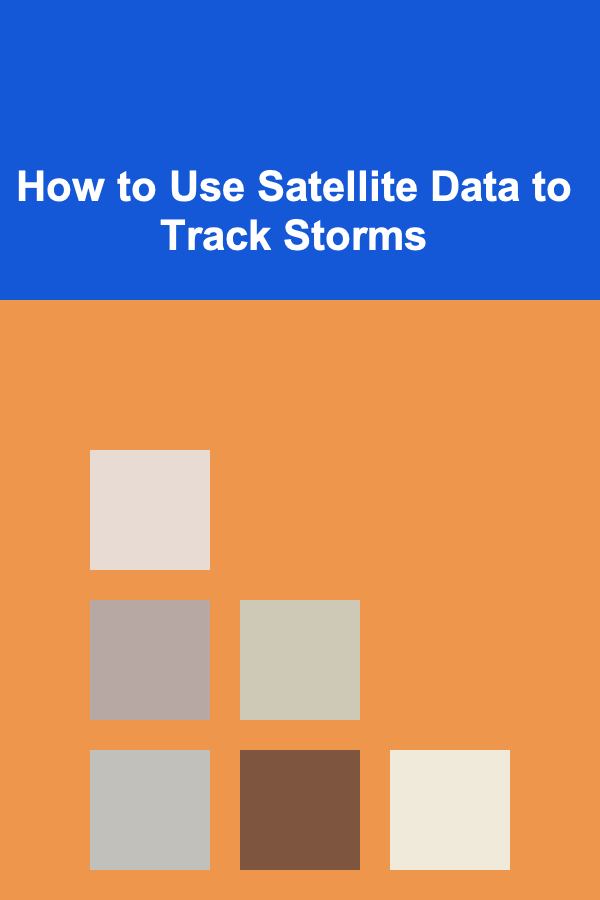
How to Use Satellite Data to Track Storms
ebook include PDF & Audio bundle (Micro Guide)
$12.99$7.99
Limited Time Offer! Order within the next:

Satellite data has become an indispensable tool for meteorologists and researchers in tracking, analyzing, and predicting storms. With the ability to provide real-time information from space, satellites offer a unique perspective that ground-based observations cannot match. From hurricanes to thunderstorms, satellites help track storm systems, providing crucial data for forecasting, disaster management, and climate studies.
In this article, we'll explore how satellite data is used to track storms, the types of satellites involved, and the methods employed to interpret the information for accurate storm prediction. We'll also examine the various satellite instruments that contribute to storm tracking and their integration into modern meteorological systems.
Understanding Storms and Their Impact
Before delving into how satellite data is used, it's important to understand the nature of storms and why accurate tracking is essential.
Types of Storms
Storms come in various forms, each with its unique characteristics:
- Hurricanes and Typhoons: These intense tropical cyclones form over warm ocean waters and are characterized by strong winds, heavy rainfall, and storm surges. They are most commonly observed in the Atlantic Ocean, Pacific Ocean, and Indian Ocean.
- Thunderstorms: Thunderstorms are convective storms that generate heavy rain, lightning, and strong winds. They can occur in almost any location around the world.
- Tornadoes: Tornadoes are violent windstorms that form in the atmosphere under specific conditions, often during severe thunderstorms. They are localized but highly destructive.
- Cyclones: Cyclones are similar to hurricanes but are primarily found in the Indian Ocean and South Pacific Ocean.
- Blizzards: These storms bring intense snowfall, low temperatures, and high winds, resulting in hazardous conditions.
Tracking these storms is vital for issuing warnings, managing evacuations, and understanding their behavior for future prediction models.
The Role of Satellites in Storm Tracking
Satellites provide invaluable data for tracking storms, offering real-time observations and global coverage. There are two primary types of satellites involved in storm tracking:
1. Geostationary Satellites
Geostationary satellites orbit the Earth at a fixed position, staying over the same area at all times. These satellites are located about 36,000 kilometers above the Earth's surface and provide continuous monitoring of weather systems in real-time. Their stationary nature makes them particularly useful for tracking large-scale storms, such as hurricanes and typhoons.
Key Features of Geostationary Satellites:
- Real-Time Monitoring: These satellites offer near-continuous coverage of the same region, making them ideal for tracking evolving storms.
- Weather Imaging: Geostationary satellites often carry advanced imaging instruments to capture high-resolution images of storm systems and their surrounding areas.
- Infrared and Visible Imaging: Infrared sensors can detect cloud top temperatures, while visible imagery provides a clearer picture of storm development and movement.
The GOES (Geostationary Operational Environmental Satellite) series by NASA and NOAA is a prominent example of geostationary satellites used in storm tracking.
2. Polar-Orbiting Satellites
Unlike geostationary satellites, polar-orbiting satellites orbit the Earth from pole to pole, passing over different regions of the planet each time they complete an orbit. These satellites offer global coverage, capturing images of the Earth's surface and atmosphere at various times of the day.
Key Features of Polar-Orbiting Satellites:
- Global Coverage: These satellites cover the entire Earth over time, making them effective for tracking storms that may be located in remote areas or over the ocean.
- High-Resolution Imaging: Polar-orbiting satellites are equipped with high-resolution instruments that allow for detailed observations of storm systems from various angles.
- Data for Numerical Models: The data from these satellites is often used in weather prediction models to simulate storm behavior and improve forecasts.
The Suomi NPP (National Polar-orbiting Partnership) and the NOAA-20 satellites are examples of polar-orbiting platforms that assist in monitoring storms.
Satellite Instruments for Storm Tracking
To track and monitor storms, satellites are equipped with a variety of sensors and instruments. These instruments provide data on different storm parameters, such as wind speed, temperature, pressure, moisture, and cloud structure. Below are some of the primary instruments used in storm tracking:
1. Visible and Infrared Imaging Radiometers
These radiometers capture both visible light and infrared radiation emitted by clouds and the Earth's surface. This data allows meteorologists to analyze cloud formation, storm structure, and temperature.
- Visible Imaging: Provides high-definition images of cloud cover, which are used to track the development of storm systems.
- Infrared Imaging: Measures the temperature of cloud tops and the surrounding atmosphere, helping to identify storm intensity and movement.
2. Microwave Sounders
Microwave sounders provide data on atmospheric moisture, temperature profiles, and precipitation. They are especially useful for observing tropical storms and hurricanes as they can penetrate cloud cover to gather data on the atmosphere below.
- Precipitation Data: Microwave sounders can measure rainfall and storm intensity by detecting water vapor and liquid water in the atmosphere.
3. Scatterometers
These instruments measure wind speed and direction by emitting microwave pulses and analyzing the scattered signals as they bounce off the ocean surface. Scatterometers help track wind patterns and intensities, which are critical for understanding the strength and movement of hurricanes and other storms.
4. Radar Systems
Some satellites are equipped with radar systems that emit radio waves to detect precipitation, storm rotation, and the structure of clouds. Radar data helps meteorologists track the intensity and movement of thunderstorms and tornadoes.
- Doppler Radar: Measures the velocity of rain and wind within a storm, allowing meteorologists to identify rotation and rotation potential for tornado formation.
5. Atmospheric Profilers
These instruments provide detailed profiles of atmospheric pressure, temperature, and humidity at different altitudes. By examining these profiles, meteorologists can assess the stability of the atmosphere and predict storm development.
How Satellites Track Storms
Now that we have explored the various satellite instruments, let's take a closer look at how this data is used to track and predict storms.
1. Data Collection
Satellites continuously collect data through their onboard instruments. Geostationary satellites, for example, provide continuous images of storm systems, allowing for real-time monitoring of storm development. Polar-orbiting satellites pass over different regions of the Earth, capturing high-resolution images and atmospheric data from various angles.
The data collected by satellites can include:
- Cloud Structure: Analysis of cloud patterns and formations helps meteorologists understand the intensity and potential path of a storm.
- Storm Movement: Satellite data is used to track the speed and direction of storm systems as they move across the Earth's surface.
- Precipitation and Wind Speed: Using radar and microwave data, meteorologists can observe precipitation levels and estimate wind speeds, which are critical in determining storm strength.
2. Data Analysis and Interpretation
Once the data is collected, it is sent to ground stations for analysis. Meteorologists use a combination of satellite data and numerical weather prediction models to analyze and forecast storm behavior.
- Storm Classification : Based on satellite observations, storms are classified according to their intensity, size, and impact. For example, hurricanes are classified using the Saffir-Simpson Hurricane Wind Scale, which measures the strength of wind speeds.
- Forecasting Path and Intensity: By examining the patterns of cloud formation, wind movement, and pressure changes, meteorologists can predict where a storm is likely to travel and how intense it will become. Numerical weather models use satellite data to simulate atmospheric conditions and predict storm development.
- Tracking and Monitoring: Satellites are also used to monitor storms in real-time. This is essential for issuing timely warnings and providing updates as the storm progresses. Meteorologists can provide emergency services and governments with up-to-date information to help guide evacuations and other disaster response efforts.
3. Storm Prediction Models
Satellite data is integral to numerical weather prediction models, which are used to predict the future behavior of storms. These models incorporate satellite observations, along with data from ground-based stations, weather balloons, and other sources, to simulate atmospheric conditions and forecast storm development.
- Global Forecasting Systems: Institutions like NOAA and the European Centre for Medium-Range Weather Forecasts (ECMWF) use satellite data to feed into global weather prediction systems that provide forecast maps for storm paths, wind speed, and rainfall.
- Track and Intensity Predictions: The data gathered from satellites helps improve the accuracy of predictions for storm path and intensity, which are crucial for disaster planning and preparedness.
Challenges in Using Satellite Data for Storm Tracking
While satellite data has revolutionized storm tracking, there are several challenges involved in using this technology:
1. Data Resolution and Coverage
Despite the vast amounts of data collected, there are limitations in resolution, particularly for polar-orbiting satellites, which only pass over the Earth's surface a few times a day. This can create gaps in data coverage, making it difficult to track rapidly developing storms in real-time.
2. Atmospheric Interference
Weather conditions such as cloud cover, rain, and snow can interfere with satellite measurements. For example, infrared measurements may be impacted by thick cloud cover, making it difficult to assess storm intensity.
3. Data Processing and Interpretation
The sheer volume of data collected from satellites can be overwhelming. It requires sophisticated algorithms and computing power to process and interpret this data in real-time. Additionally, the complexity of storm behavior means that there's often a degree of uncertainty in storm predictions, even with accurate satellite data.
Conclusion
Satellite data plays a crucial role in storm tracking, offering meteorologists an unparalleled view of storm systems and atmospheric conditions. With the combination of geostationary and polar-orbiting satellites, as well as advanced instruments like radar, microwave sounders, and infrared imaging, we can now monitor storms with greater accuracy and efficiency. These technologies not only improve storm prediction and intensity forecasting but also help in disaster management and climate research.
As satellite technology continues to advance, it is likely that our ability to track storms will become even more precise, providing us with the tools necessary to mitigate the impacts of severe weather and protect communities around the world.
Reading More From Our Other Websites
- [Organization Tip 101] How to Organize Pet Supplies for Easy Access
- [Personal Financial Planning 101] How to Invest in Cryptocurrency: A Beginner's Guide to Digital Assets
- [Scrapbooking Tip 101] Mix & Match: Pairing Vintage and Modern Embellishments for a Fresh Look
- [Polymer Clay Modeling Tip 101] How to Create Custom Polymer Clay Terrain Tiles for Tabletop Gaming Landscapes
- [Personal Care Tips 101] How to Make Nail Polish at Home
- [Home Maintenance 101] How to Keep Your Deck Safe and Beautiful: Maintenance and Repair Tips
- [Tie-Dyeing Tip 101] The Science of Color: How to Choose Dyes for Stunning Shibori Effects
- [Ziplining Tip 101] Best Zipline Conservation Projects Supporting Reforestation in Madagascar's Rainforests
- [Home Staging 101] How to Create a Cozy Cottage Feel in Your Home Staging
- [Screen Printing Tip 101] Step-by-Step: Designing Custom T-Shirts with Professional Silk Screen Techniques

How to Align Your Budget with Your Values
Read More
How to Create a Minimalist Home Office for Focus
Read More
How to Manage Your Debt and Avoid Financial Stress
Read More
How to Organize a DIY Home Scavenger Hunt for Kids
Read More
How to Handle Long-Distance Dating
Read More
Unlocking Potential: A Step-by-Step Journey
Read MoreOther Products

How to Align Your Budget with Your Values
Read More
How to Create a Minimalist Home Office for Focus
Read More
How to Manage Your Debt and Avoid Financial Stress
Read More
How to Organize a DIY Home Scavenger Hunt for Kids
Read More
How to Handle Long-Distance Dating
Read More